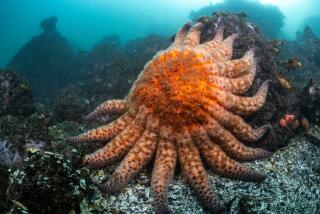Moray Eel Slithers Into Hawaii Picture
- Share via
Hawaii has its sharks, but lurking in the cavernous depths of the islands is another frightening creature with a big bite: slithering serpents of sorts known as giant moray eels.
They don’t appear very often, but when they do, jaws drop.
Kimo Lopes was the latest to encounter one. While diving at a depth of about 80 feet recently off Kailua-Kona on the big island of Hawaii, Lopes came face to face with a moray that measured seven feet and weighed 150 pounds.
He knew nobody would believe him, so he speared the eel twice, and despite its needlelike teeth and powerful jaws, he wrestled it to the surface and brought it to the scales at Honokohau Harbor. Lopes acted very much like a dragon slayer, posing with the eel draped around his neck for the cover of the Oahu-based Hawaii Fishing News.
According to a report in the February issue of Western Outdoors magazine, the photograph piqued the interest of Hawaiian scientists, who assured the public that encounters with giant morays are extremely rare.
However, Dr. Richard Brock of the University of Hawaii recalled a day in 1947 when his father speared a 10-foot eel, only to watch in horror as the animal broke free and latched onto his arm. The father broke free but suffered serious injuries.
A Maui diver recalled the time a large eel attacked the freshly speared fish he was dragging behind while diving. The diver, Eddie Rosaga, tried to shoot the eel, but it shredded the shaft of his spear with a savage bite.
*
On the subject of sea monsters, an ominous black one surfaced the other day off Anacapa Island--attached to the line of Thousand Oaks angler Chris Lomax, who was fishing aboard the Oxnard-based Gentleman.
Actually, it was a black sea bass, but it was a big one--weighing an estimated 300 pounds. Skipper Donny Rowell said that after the initial fight, the fish came floating to the surface like a giant balloon.
As is the case with numerous species of bottom fishes, giant sea bass--or black sea bass as they are more commonly called--have air bladders, which govern the depths at which they can swim. When the pressure becomes too great, the bladder inflates, sometimes protruding out of the mouth of the fish, and it becomes largely immobile.
When that happened to Lomax’s fish, Rowell did the gentlemanly thing: He stuck a needle in the bladder, deflating it and enabling the fish to descend. “And he swam back down like a champ,” Rowell said.
Giant sea bass are protected by state law and must be released. They once thrived along the west coast of California and Baja California, but because of their passive nature--except when feeding--their numbers were decimated by divers and fishermen over the years.
The all-tackle record, a 563.8-pounder caught in 1968 before the fish were protected, was also taken at Anacapa.
*
At Cabo San Lucas, a streamlined stranger with a funny-looking nose is turning heads.
Short-billed spearfish are showing in unusually large numbers. Only one or two are caught each year, but several were landed last week.
One group from Las Vegas, visiting the resort city at the tip of the Baja peninsula, experienced triple hookup on the scrappy spearfish, landing a 75-pounder, releasing one at the boat and losing the other during the fight. Several others were weighed, including a 70-pounder by Costa Mesa’s Bob Bisbee Jr.
Nobody can explain the phenomenon, but one fleet owner accurately described it as “quite astonishing.”
*
Not to be overlooked is the 4-pound 10-ounce crappie that made news recently in Virginia. The big slab of fish, caught in a private pond, is the biggest crappie taken in that state. And it was reeled in by 4-year-old Justin Elliott--on his Donald Duck-model fishing pole.
Briefly
HUNTING--Interest in hunting big game might be waning in California, but it is soaring for ducks and geese. The Department of Fish and Game processed 244,721 waterfowl applications for the 1994-95 season, more than double the applications received seven years ago. The DFG credits the increased availability and productivity of state and federal areas, and the large number of ducks and geese in the Pacific Flyway this season.
*
NATURE--Cabrillo Marine Aquarium in San Pedro is offering guided tide pool walks at the Point Fermin Marine Life Refuge Saturday from 1:30-3 p.m. and Feb. 25 from 1-2:30 p.m. Cost is $1. Details: (310) 548-7563. . . . This being the rainy season, the Los Angeles Mycological Society will conduct three mushroom-hunting “forays” Feb. 18. The purpose of the trips is to collect wild mushrooms for display at the LAMS mushroom fair at the L.A. County Arboretum in Arcadia on Feb. 19. Trips are scheduled at Malibu Creek State Park, Placentia Canyon County Park and Cleveland National Forest in Orange County. Details: (213) 292-1900.
*
MISCELLANY--The Redondo Beach Pier, destroyed by a fire and heavy surf in 1988, will reopen Saturday, with special areas designated for fishing, though finishing touches such as rod-holders, sinks and cutting boards are not expected until the end of February.
More to Read
Sign up for Essential California
The most important California stories and recommendations in your inbox every morning.
You may occasionally receive promotional content from the Los Angeles Times.













